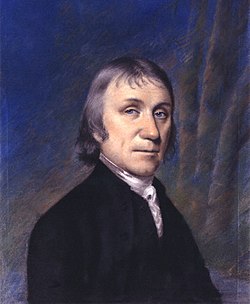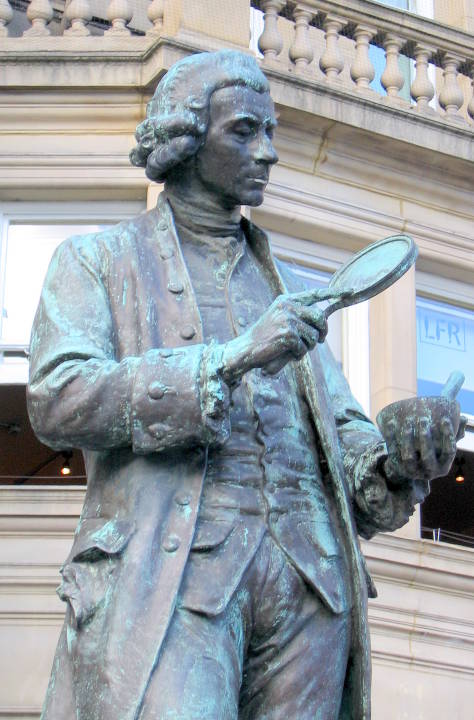Why Joseph Priestley is our man for climate research

Joseph Priestley could not be a more appropriate individual to inspire the work of our centre for climate change research at the University of Leeds.
Interdisciplinary research is at the heart of what the Priestley International Centre for Climate does and Priestley, a son of Yorkshire – he was born in 1733 in Birstall, a few miles from Leeds – was an intellectual and experimentalist who was prolific in many fields, from the physical sciences to philosophy, politics and education. A clergyman, chemist and ‘furious freethinker’, he was interested in both scientific methodology and the practical application of science and he was driven by a quest for solutions, particularly to the problems of human health.
Doing research to underpin solutions is core to our work too, and our focus on the global challenge of climate change is informed by some of the ground-breaking discoveries about scientific processes Joseph Priestley made two and a half centuries ago.
Carbon dioxide (CO2), the main greenhouse gas causing human-induced global warming, was the subject of Priestley’s earlier experiments. The gas had been discovered by Joseph Black in 1754 and was then called ‘fixed air’ (hydrogen was ‘inflammable air’ and ‘air’ itself was still seen as a single element). Priestley ‘amused himself’ by testing the fermentation fumes at his local brewhouse (the forerunner to the famous Tetley Brewery), which was adjacent to his home in Meadow Lane in Leeds, corralling the brewery hands into undertaking tasks involving burning candles and wood.
Back in 1767, he could not have known the effect that this gas would have in altering the climate and changing ecosystems. Nor could he have realised the vital relationship that carbon sources and sinks have in regulating atmospheric carbon, although he did start us on the road to understanding the carbon cycle with his classic bell jar experiments involving green shoots, mice and burning candles, which were the first observations of the process of photosynthesis and respiration in plants and animals.
Priestley went on to isolate ten other gases in air including carbon monoxide, ammonia, sulphur dioxide, hydrogen sulphide and nitrous oxide (so-called ‘laughing gas’), which was later used as the first anaesthesia and is also a powerful greenhouse gas. In 1772 he was awarded the Royal Society’s prestigious Copley Medal for his ‘many curious and useful Experiments contained in his observations on different kinds of Air’, which included the experiments with carbon dioxide.
Among the more famous impacts of this work was his invention of soda water, produced by impregnating water with CO2, which he hoped would treat scurvy in sailors. It didn’t, but it did subsequently launch a profitable business in mixers for one J. J. Schweppe.
Priestley is, of course, most famous for his discovery of oxygen (1774), which he called ‘dephlogisticated air’. Phlogiston was an archaic concept, believed to be the flammable property of a material; the name ‘oxygen’ came later from Anton Lavoisier, who built on Priestley’s work but rejected the phlogiston theory (which Priestley himself clung to stubbornly all his life). Priestley made his discovery by focusing sunlight through a burning lens onto mercuric oxide, also called red calx. He found the gas released gave him an uplifted sensation: ‘The feeling of it in my lungs was not sensibly different from that of common air, but I fancied that my breast felt peculiarly light and easy for some time afterwards’.

Statue of Joseph Priestley in City Square in Leeds, showing him focussing sunlight onto mercuric oxide
Priestley’s achievements are all the more extraordinary since he was largely self-taught (his schooling, at Batley Grammar, was cut short by ill health) and he had little formal education in science; neither was he permitted to attend an English university due to his dissenting religious views against the Church of England. Perhaps this unorthodox background was why he felt no constraints in exploring his wide range of intellectual interests.
Certainly today, a scholar who could produce a key text on grammar, a notable chart of biography, a history of optics and get a prestigious offer as an astronomer – Priestley was asked to join Captain James Cook’s second voyage but could not take it up because of the crew’s objections to his religious views – can truly be called interdisciplinary.
During his time in Leeds - Priestley lived there from 1767 to 1773 – he was minister of a Presbyterian congregation at Mill Hill Chapel (turning the congregation Unitarian in the process) and helped to found The Leeds Library in Commercial Street. It was a prolific period for the Yorkshire polymath and it was while he lived here, with his family and wife Mary, that he undertook his work on gases.
Priestley also published a landmark political book on civil liberties, ‘An Essay on the First Principles of Government’, which influenced the utilitarian philosophy of Jeremy Bentham, as well as a much-respected and substantial volume, The History and Present State of Electricity. This expanded on work previously undertaken on the conductivity of carbon that produced the forerunner to Coulomb’s inverse-square law, which had earned him a fellowship of the Royal Society in 1766.
He even came up with an illustrated version for lay readers, for which he taught himself to draw. In the process he invented the rubber from India gum for erasing pencil marks – a prosaic but practical solution that generations of school children since have been thankful for.
Priestley and his family moved to Birmingham in 1780, where the dissenting nature of his writing on theology and government saw him gain increasing notoriety as an anti-establishment figure. He was regarded as an atheist because he rejected the virgin birth, his support for the French Revolution was reviled and his views on public accountability of the monarchy upset King George III. In 1791 an angry mob burned down his house and laboratory and the Priestleys were forced to flee to London.
Life in England became increasingly difficult for him and Priestley ended his years in the United States of America, having moved to Pennsylvania to continue his scientific work. He died in 1804, just as the Steam Age was transforming the way people lived and worked, founding an economy and a society driven by coal.
The carbon dioxide released into the atmosphere by the burning of fossil fuels that began at scale in Priestley’s lifetime with the industrial revolution poses the biggest challenge facing the world today. Understanding the impacts of increasing levels of carbon dioxide is a key part of the work of the Priestley International Centre for Climate, which is committed to producing robust research to underpin policy solutions to the global challenge of climate change. An interdisciplinary approach that makes connections across disciplines is essential to that.
We take Joseph Priestley, a local man, brilliant chemist and one of the eighteenth century’s most inventive minds, for our namesake and our inspiration.
Sources:
Famousscientists.org; biography.com; famousbiologists.org; historyguide.org; chemheritage.org; Spartacus-educational.com; Britannica.com; acs.org; revolutionaryplayers.org; josephpriestley.org; biography.yourdictionary.com; ypsyork.org; rsc.org; secretlibraryleeds.net; mattson.creighton.edu; scienceleftuntitled.wordpress.com; breweryhistory.com
